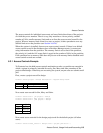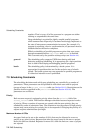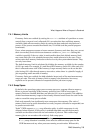Accounting
1. No CPU usage limits are set on jobs run by the root user.
2. If the user has an access control record for the partition, the CPU usage limit is
determined by the maxcpus field in this record.
3. The access control record for the user’s current project determines the CPU usage
limit.
4. The access control record for the default project determines the CPU usage limit.
CPU usage limits can be set to a higher value than the actual number of CPUs available
in the partition. This is useful if gang scheduling and time slicing are in operation on
the partition. For example, if a partition has 16 CPUs and the usage limit for a given
user is 32 then RMS will allow two 16 CPU jobs to run (see Section 7.4.3 for details).
6.5 Accounting
As each request is allocated CPUs, an entry is added to the accounting statistics
(acctstats) table (see Section 10.2.2) specifying the following details about the job:
name Resource name (see Section 10.2.18).
uid Identifier of the user.
project Name of the user’s current project.
started Time at which resources were allocated (UTC).
etime Elapsed time (in seconds) since CPUs were allocated.
atime Time (in CPU seconds) for which CPUs have been allocated. Note that
atime stops ticking while a request is suspended.
utime Time (in seconds) for which processes were executing in user state.
stime Time (in seconds) for which processes were executing in system state.
cpus Number of CPUs allocated.
mem Maximum memory extent of the program in megabytes.
pageflts Number of page faults requiring I/O summed over processes.
memint Memory integral for the program in megabyte hours.
running Set to show that the CPUs are in use.
6-6 Access Control, Usage Limits and Accounting


















